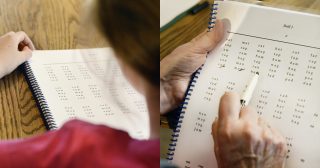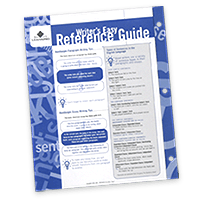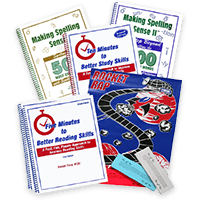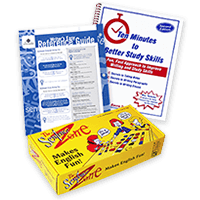How To Improve Reading Skills With a Non-verbal Autistic Student
March 17th, 2009This question just came in from Penny Ray:
Hi Bonnie!
I have a question about “Five Minutes to Better Reading”. Have you used that program with a non-speaking student? What do you recommend for non-speaking (non-verbal autistic) kids in terms of boosting reading skills?
Am looking for anything that would help.
Thanks,
Penny Ray
Hi Penny,
There is a way to use the Five Minutes to Better Reading Skills with a non-speaking student, providing they can read the 3 letter words it starts with.
1. Get one more clear plastic sheet and one more dry erase marker.
2. Your student places a clear plastic sheet on top of his copy of the drill & you place a clear plastic sheet on top of yours.
3. Sit across from each other.
4. You will need to prop your book somewhat upright so he/she can’t see when you make a mark on your sheet.
5. You will then read the drill to the student, practicing it – put in a few mistakes – mark when you make a mistake.
6. The student needs to mark on his/her plastic when you make a mistake too.
7. Compare sheets – did the student mark the same mistakes as you did – ‘catching’ your mistakes?
8. Then do the timed read for one minute. Try to read the drill a little bit faster, BUT, be sure to put in mistakes again. Mistakes can be skipping a word, repeating a word,
skipping a line, or mispronouncing a word.
9. The student needs to catch whatever mistake you make.
10. If the student catches all of your mistakes, he/she is reading at 100%. You will need to figure out the percentage of errors he/she catches in order to keep track of the scoring for the student (words per minute & errors per minute that he/she caught vs words per minute & errors that were actually made).
Other non-speaking reading activities would include:
1. Pointing to the word I say, or the sentence I am reading and then a particular word or phrase with the sentence.
2. Circling all of a particular word on a page.
3. Reading a story without pictures and then drawing pictures to go with it – so there are no picture clues ahead of time. that way you know if they really read the story and understood/comprehended it.
4. Use magnetic letters for them to write the word you are saying.
5. Use word cards and have them arrange them into sentences (The Sentence Zone game would allow them to do this – it comes with over 700 color-coded word cards.)
Hope this is helpful.
Bonnie Terry, M. Ed., BCET




























Thanks, Bonnie! I know many families who have non-speaking children on the autism spectrum, and some read my blog, so I wanted to have information for those families, too!
there is still no permament solution for autism. we just have to take good care of the kids who are suffering autism.**;
there is no permanent cure for autism yet, most autism treatments are experimental*:.
You are absolutely correct, there is no ‘cure’ for autism yet, but early intervention has shown to make a difference. One of the keys is to understand the strengths and weaknesses of your child – in the 9 areas of visual perception, the 9 areas of auditory perception, and the 9 areas of tactile/kinesthetic perception. Even when you child is autistic, they have strengths and weaknesses in these areas. When you know the problematic areas you can start to address them and really make a difference.
This is a great tip. A younger cousin of mine is showing signs of autism but unfortunately his mother doesn’t agree so won’t have a professional spend time with him to find out. I’d still like to help him with his education and this may be the best way to do it. Thanks for the info x
Kerrie
I actually do neural-developmental assessments that are behaviorally based. You might want to do that. Then you would know the underlying causes of the problems. the assessment is actually done with the parent – I ask a set of questions and the answers are yes, no, or sometimes. There is a scoring mechanism and then the following day I go over the results with you. I also design a program specific to your child’s needs according to the results of the assessment. Then I provide you with the materials and work with you for 12 weeks so you know how to implement the program. Here is a 20 minute video that goes into more detail on our Awaken the Scholar Within Program.
Bonnie Terry, M. Ed., BCET
to date, there has been no cure for autism yet and we always hope that stem cell research can cure it~**
i have a brother that is autistic and we love him so much and gave all of our support on him “`*
Thanks for your comment. Glad it is helpful.
Thank you!
forums built in the very same subject matter? Thank you!
I don’t know if there are forums on this subject matter but I will be hosting a new radio show called Learning Made Easy Talk Radio where we will be talking about this among other things. It will be on Sundays at this site: http://amazingwomenofpower.com/